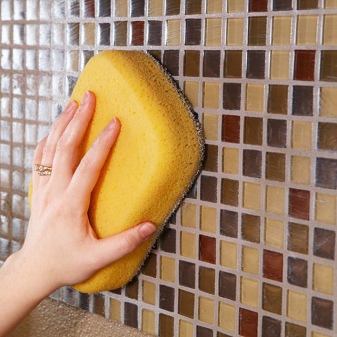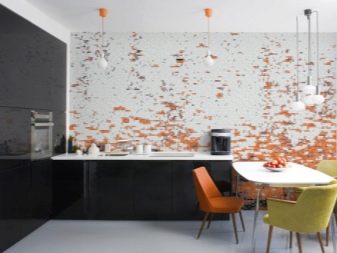Mosaic for the kitchen: features, types and design

Using mosaics in an interior is a very effective way to refresh and brighten it. Mosaic masonry in the kitchen is an original replacement for conventional ceramic tiles, allowing you to diversify the interior decoration of the kitchen. A wall panel made of this material can turn the most ordinary kitchen wall into a real work of art.


Advantages and disadvantages
At first glance at the mosaic wall and during subsequent operation, its advantages are revealed, such as:
- the ability to compose unusual and stylish compositions;
- a huge variety of colors, shapes, sizes and materials;
- fits perfectly into the interior of any style;
- resistant to moisture;
- increased thermal stability of the mosaic coating;
- UV resistance, burnout protection.


A beautiful mosaic canvas, in addition to its advantages, has some disadvantages.
- An original mosaic wall requires special care from the very beginning of its installation. It is necessary to regularly treat the surface with special agents against mold, antifungal, dirt and moisture repellent agents.
- Due to the small size of the chips, the maintenance of the mosaic is complicated by the presence of a large number of seams.
- The installation work is much more difficult than the installation of regular full-size tiles. Its laboriousness can be compared with jewelry craftsmanship.
- Compared to other materials, the cost of the mosaic together with its installation is much more expensive.


How to use?
Mosaics are used as decoration on many kitchen surfaces.
Among them:
- walls;


- floor;

- ceiling;

- apron;


- shelves;

- countertops.


The most popular is the mosaic decoration of the apron of the working area, which can be made in any style. Depending on the size, color scheme and pattern, you can create an independent bright spot in the kitchen room or a surface that harmoniously merges with the walls and furniture.


Tile size
Mosaics are not sold as individual tiles called chips, but printed on a mesh or paper matrix. Standard matrix sizes are usually of the following sizes: 24x24 cm, 28x28 cm, 30x30 cm, 31.5x31.5 cm, 32x32 cm and others. On average, 9 matrices are consumed per 1 square meter of surface.
The size of the chips themselves can also vary. The most common are matrices assembled from chips with sizes from 1x1 cm to 5x5 cm.
Matrices made up of 10x10 cm elements are also on sale.


Beautiful examples and materials
Many characteristics of a mosaic depend on the material from which it is made.
Glass
Glass mosaics are one of the most commonly used options in the kitchen. It is distinguished by a large variety of colors and textured solutions. Chips made of glass can be glossy, matte, transparent, translucent, glitter, foil.
One of the varieties of glass-containing raw materials for mosaics - smalt - is made of colored pressed glass.
Such a mosaic is characterized by increased strength, as well as inhomogeneity and saturation of shades.


Another type of glass mosaic is mirror. She looks very impressive in modern styles such as hi-tech, art deco. The property of mirrors to expand the area is actively used in small kitchen areas.


The disadvantage of glass mosaic chips can be their fragility. Handling a glass mosaic matrix requires care and care.
Glass and mirror tile mosaics are very often combined with regular tile. In terms of the cost of work and material, such compositions are much cheaper than those that are completely laid out from mosaics.

Ceramics
Ceramic mosaic is also actively used in the finishing work in the kitchen. The color palette and shape of ceramic chips is quite varied in order to make the right choice. Its mechanical and performance properties are similar to those of ceramic tiles. It is resistant to high temperatures and moisture, quite durable.
Compared to glass mosaic, ceramic may seem a little simpler to design. Laying and caring for ceramic mosaic panels also requires some effort and time.
Ceramic mosaic with a metallic effect is composed of ceramics, plastic and rubber.
The metallized surface is obtained by processing it with stainless steel.


Stone
Stone products are considered one of the most durable. Pieces of mosaic are cut from natural stone: marble, granite, onyx, lapis lazuli and others. The surface of stone chips can be smooth and rough. The stone mosaic looks expensive and prestigious.
It should be noted that some types of stone, such as marble and limestone, have a porous structure that absorbs moisture and is not suitable for use in the kitchen work area for laying an apron.
The color assortment of stone mosaic is not as wide as that of glass. Therefore, these two types are often combined with each other.

Porcelain stoneware
Porcelain stoneware is an artificial material similar in appearance to stone. Porcelain stoneware mosaic has a large selection of textures: rough, embossed, matte, glossy.
For the price, porcelain stoneware mosaic is more expensive than glass or ceramic, but cheaper than stone. At the same time, the porcelain stoneware mosaic canvas looks very natural.

Nacre
Mother-of-pearl is an organic substance that accumulates in the inner layer of shells. The mother-of-pearl mosaic is characterized by beautiful iridescent tints. This is one of the most spectacular and most expensive types of mosaics.
By its properties, mother-of-pearl is excellent for laying out a kitchen apron, since it perfectly withstands temperature extremes and high air humidity. And thanks to its physical properties - extraordinary beauty overflows - it fits perfectly into most famous design styles, while expanding the size of the room and giving a feeling of spaciousness.
In order to save money, it is possible to create mother-of-pearl mosaic panels using imitation from smalt.

Colour
The mosaic can be laid out in one tone, or whole pictures and ornaments can be created.
Black
Black mosaic in the interior of the kitchen looks like an original design solution. At the same time, black mosaic is allowed to be used both as an independent monochrome material, and in combination with mosaics of other colors.
A popular combination of black and white chips. In this case, designers rely on the contrast of elements. The black and white mosaic apron suits many styles. The proportions of black and white do not have to be equal. You can make more black and the surface becomes more mysterious, or more white to expand the space.


Gray
Gray mosaic in the kitchen fits perfectly with styles such as Provence and high-tech. By itself, a calm gray will bring calmness and tranquility to the kitchen.Since gray does not oblige you to anything, in addition to the gray mosaic, it is quite possible to pick up chips of other colors and shades: yellow, pink, white, thereby creating stylish beautiful patterns or, laying the mosaic in a random manner, make a kind of fantasy plot.


The beauty of gray mosaic is also in the fact that it is able to favorably emphasize furniture and interior details in a different color scheme. For example, light shades of wood or bright red facades of cabinet furniture, as well as sky blue and snow-white colors, are perfectly combined with gray.

Gold
Gold mosaic in the interior of the kitchen is a sign of luxury and well-being. Mosaic chips with a gold surface can be made from glass, ceramics, metal and other materials. To create a golden effect, the production technology provides for the addition of gold-containing mixtures to the raw materials. Gold mosaics can have different shades: honey, amber or closer to bronze.
Along with the stunningly beautiful appearance, the gold mosaic is accompanied by a high price that not everyone can afford.
In addition, the presence of golden mosaics in the kitchen obliges the rest of the decor and furniture elements to be related to the same luxurious style.


Designers recommendations
When creating mosaic panels in the kitchen, all circumstances should be taken into account, which will help preserve the mystery and identity of the room for cooking and eating.
- The size of mosaic chips directly affects the visual perception of the size of the room: large ones decrease them, and small ones increase them.
- And also mirror options will work to increase the size of the room.
- Diamond-shaped mosaic elements reduce the size of the room. They should be used with caution in rooms with a lack of space.
- To create an aesthetic effect in the kitchen and revitalize it, complex mosaic ornaments are often used.




See below for more details.













The comment was sent successfully.